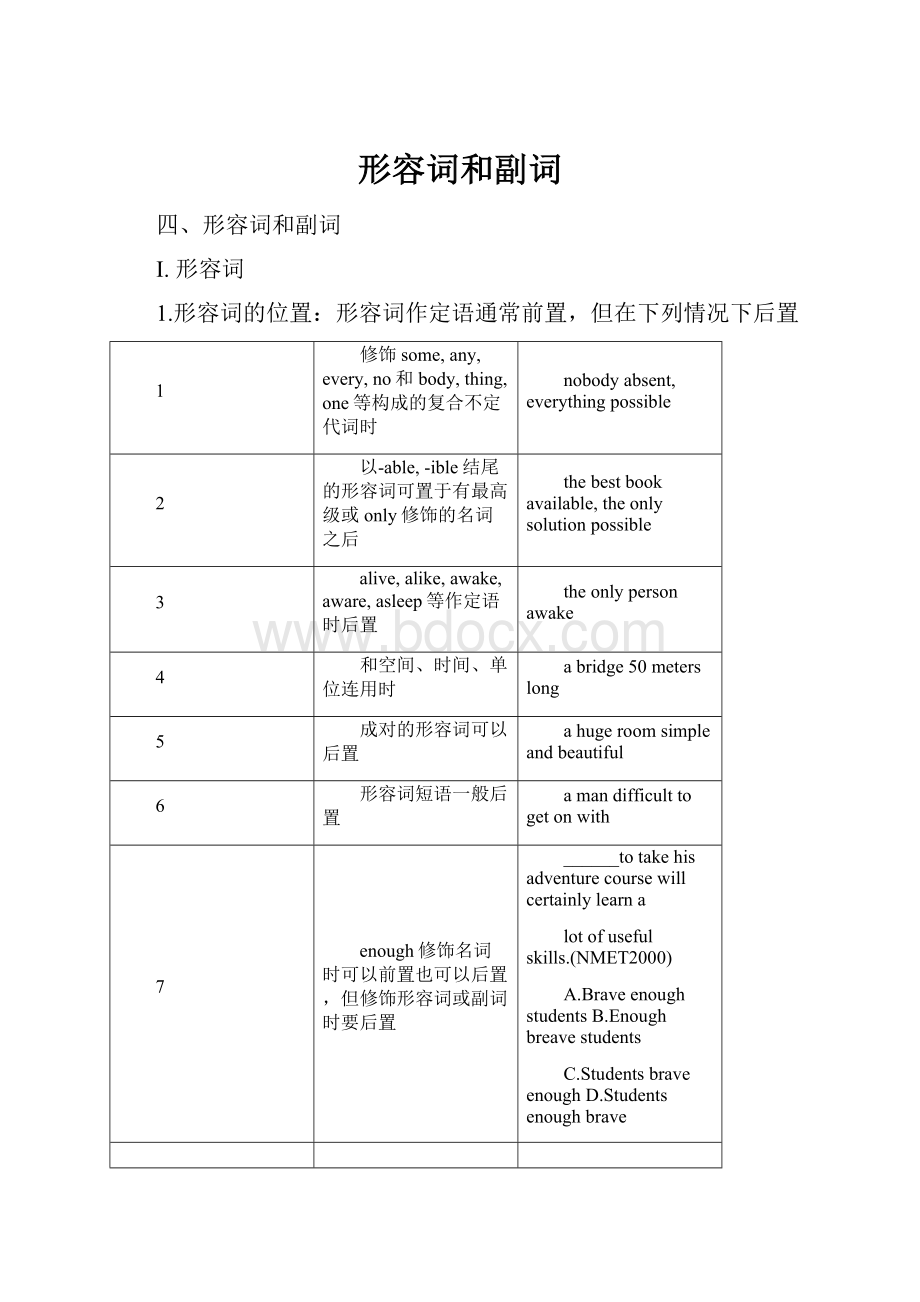形容词和副词.docx
《形容词和副词.docx》由会员分享,可在线阅读,更多相关《形容词和副词.docx(23页珍藏版)》请在冰豆网上搜索。

形容词和副词
四、形容词和副词
I.形容词
1.形容词的位置:
形容词作定语通常前置,但在下列情况下后置
1
修饰some,any,every,no和body,thing,one等构成的复合不定代词时
nobodyabsent,everythingpossible
2
以-able,-ible结尾的形容词可置于有最高级或only修饰的名词之后
thebestbookavailable,theonlysolutionpossible
3
alive,alike,awake,aware,asleep等作定语时后置
theonlypersonawake
4
和空间、时间、单位连用时
abridge50meterslong
5
成对的形容词可以后置
ahugeroomsimpleandbeautiful
6
形容词短语一般后置
amandifficulttogetonwith
7
enough修饰名词时可以前置也可以后置,但修饰形容词或副词时要后置
______totakehisadventurecoursewillcertainlylearna
lotofusefulskills.(NMET2000)
A.BraveenoughstudentsB.Enoughbreavestudents
C.StudentsbraveenoughD.Studentsenoughbrave
注意:
多个形容词修饰同一个名词的顺序
熟记口诀就可以顺利解题:
限定描绘大长高,形状年龄和新老,颜色国籍跟材料,作用类别往后靠。
规则:
限定语(The、A)+描绘性形容词+size(小)+shape(形状)+age(年龄、时间)+color(颜色)+origin(国籍、来源)+material(材料)+purpose(目的)+名词。
▲This________girlisLinda’scousin.(05北京卷)
A.prettylittleSpanishB.SpanishlittleprettyC.SpanishprettylittleD.littleprettySpanish
2.复合形容词的构成
1
形容词+名词+ed
kind-hearted
6
名词+形容词
world-famous
2
形容词+形容词
dark-blue
7
名词+现在分词
peace-loving
3
形容词+现在分词
ordinary-looking
8
名词+过去分词
snow-covered
4
副词+现在分词
hard-working
9
数词+名词+ed
three-egged
5
副词+过去分词
newly-built
10
数词+名词
twenty-year
3.形容词(短语)作伴随状语
Ashelookedatthegoat,itrolledover,dead.当他看着山羊的时候,山羊翻了个身,死了。
Afraidofdifficulties,theyprefertotaketheeasyroad.由于害怕困难,他们宁愿走好走的路。
II.副词的分类:
1
时间副词
soon,now,early,finally,once,recently
5
频度副词
always,often,frequently,seldom,never
2
地点副词
here,nearby,outside,upwards,above
6
疑问副词
how,where,when,why
3
方式副词
hard,well,fast,slowly,excitedly,really
7
连接副词
how,when,where,why,whether,however,meanwhile
4
程度副词
almost,nearly,very,fairly,quite,rather
8
关系副词
when,where,why
III.形容词和副词的比较等级
形容词和副词的比较等级分为原级,比较级和最高级。
比较级和最高级的构成一般是在形容词和副词后加-er和-est,多音节和一些双音节词前加more和most。
项目
例句
同级比较时常常用as…as…以及notso(as)…as…
Sheisastallashermother.
Iamnotas/sogoodaplayerasyouare.
双方比较,表示一方超过另一方时,用“比较级(+than)”
的结构表示。
要注意题干中将比较的另一方阴藏起来的情况。
Thispictureismorebeautifulthanthatone.
Ihaveneverseensuchamoreinterestingfilm(thanthisone).
表示一方不及另一方时,用“less+原级+than”的结构表示
Thisroomislessbeautifulthanthatone.
表示一方随另一方变化时用“themore…themore…”句型
Theharderyouwork,themoreprogressyouwillmake
用比较级来表达最高级的意思
Ihaveneverspentamoreworryingday.
我从来没有度过这样令人烦恼的一天。
(意为:
我度过了最为令人烦恼的一天。
)
倍数的表达
表达法一:
Aisthree(four,etc.)timesthesize(height,lengthetc.)ofB.
Thenewbuildingisfourtimesthesize(theheight)oftheoldone.
这座新楼是那座旧楼的四倍大(高)/这座新楼比那座旧楼大(高)三倍。
表达法二:
Aisthree(four,etc.)timesasbig(high,long,etc.)asB.
AsiaisfourtimesaslargeasEurope.
亚洲是欧洲的四倍大/亚洲比欧洲大三倍。
表达法三:
Aisthree(four,etc.)timesbigger(higher,longer,etc.)thanB.
Yourschoolisthreetimesbiggerthanours.
你们的学校比我们的学校大三倍。
用times表倍数通常用于三倍以上,两倍可以用twice或double.
注意:
1.可以修饰比较级的词有:
much,many,alot,even,far,abit,alittle,still,yet,byfar,any,agreatdeal;
2.表示“最高程度“的形容词没有最高级和比较级。
如:
favourite,excellent,extreme,perfect,superior,junior等。
语法复习专题四——形容词和副词
一、考点聚焦
1、形容词、副词的作用与位置
形容词是用来修饰名词的,常被放在名词前作定语,或放在系动词后面作表语。
而副词则用来修饰形容词、动词,其他副词或者句子,一般位于形容词之前,动词之后或句子之首。
以下属几种特殊情况,须牢记;
(1)形容词短语作定语,定语后置。
alanguagedifficulttomaster,aleaningtowerabout180feethigh
(2)表语形容词(afraid、alike、alone、asleep、awake、alive等)作定语,定语后置。
如amanalive。
有些表身体健康状况的形容词如well、faint、ill只作表语。
sick既可作表语又可作定语,ill如作定语意为“bad”。
(3)用作定语,修饰由不定代词one、no、any、some和every构成的复合词如anything、something等时,通常后置。
如:
Ihavesomethingimportanttotellyou.
(4)else常用作疑问代词和不定代词的后置定语。
(5)enough、nearby修饰名词前置或后置,程度副词一般位于形容词、副词前面,enough修饰形容词、副词时,必须后置。
(6)几个副词并列作状语时,其顺序较灵活,但一般是:
方式→地点→时间。
如:
WehadagoodtimetogetheroutdoorslastSunday.
(7)频度副词如often、always、usually等在be动词后,行为动词前。
(8)副词作定语,定语后置。
如:
Thepersonthereiswaitingforyou.
(9)几个并列的形容词作定语,其语序通常为:
限定语(The、A)+描绘性形容词+size(大小)+shape(形状)+age(年龄、时间)+color(颜色)+origin(国籍、来源)+material(材料)+purpose(目的)+名词。
如:
aheavyblackChinesesteelumbrella,
theman’sfirsttowinterestinglittleredFrenchoilpaitings
(10)以-ly结尾的词性辨析。
①下列单词以-ly结尾,但却是形容词而非副词:
lively、lonely、lovely、deadly、friendly、ugly、silly、likely、brotherly、timely等。
②表愿意(无-ly)和引申意(有-ly)的副词:
deep深wide宽广high高low位置低
deeply深入地widely广泛地highly高度地lowly地位卑微
③有无-ly意义大不相同的副词:
dead完全,绝对bedeadasleep
deadly非常bedeadlytired
pretty相当beprettycertainthat…
prettily漂亮地beprettilydressed
close近Don’tsitclose.
closely密切地Watchclosely!
late晚、迟arrivelate,comelate
lately最近Ihaven’tseenhimlately(recently).
2、复合形容词的构成
(1)形容词+名词+ed
kind-hearted好心的,white-haired白发的
(2)形容词+形容词
red-hot炽热的,dark-blue深蓝的
(3)形容词+现在分词
good-looking好看的,easy-going随和的
(4)副词+现在分词
hard-working勤劳的,fast-moving快速转动的
(5)副词+过去分词
hard-won得来不易的,newly-made新建的
(6)名词+形容词
life-long终生的,world-famous世界闻名的
(7)名词+现在分词
peace-loving爱好和平的,fun-loving爱开玩笑的
(8)名词+过去分词
snow-covered白雪覆盖的,hand-made手工的
(9)数词+名词+ed
four-storeyed4层楼的,three-legged3条腿的
(10)数词+名词(名词用单数)
ten-year10年的,two-man两人的
3、形容词和副词的比较等级
(1)原级的构成和用法。
构成:
形容词、副词的原级即本身。
用法:
表示双方在程度、性质、特征等某方面相等时,用“as+原级形容词/副词+as”的结构;表示双方不相等时,用“notso(as)+原级形容词/副词+as”的结构;表示一方是另一方的若干倍时,用“倍数+as+原级形容词/副词+as”的结构。
如:
XiaoWangisastallasXiaoYu.
Thisbuildinglooksnotso(as)highasthatone.
MissXuspeaksEnglishasfluentlyasyou.
Thisroomisthreetimesaslargeasthatone.
(2)比较级和最高级的构成。
掌握比较级和最高级的变化规则,熟记少数不符合规则的特殊形容词和副词。
(3)比较级的用法。
①对方比较,表示一方超过另一方时,用“比较级+than”的结构表示。
如:
Thispictureismorebeautifulthanthatone.
②表示一方不及另一方时,用“less+原级+than”的结构表示。
如:
Thisroomislessbeautifulthanthatone.
③表示一方超过另一方的程度或数量时,可在比较级前加表示程度的状语,如even、alot、abit、alittle、still、much、far、yet、byfay等修饰。
如:
Heworksevenharderthanbefore.
注意:
英语的比较级前如无even、still或yet等时,译成汉语时可用“较”或“…一些”或不译出,一般不可有“更”。
如:
Sheisbetterthanshewasyesterday
Pleasecomeearliertomorrow.
另注意:
byfar通常用于强调最高级。
用于比较级时,一般放在比较级的后面,如在前面,应在二者中间加“the”。
如:
Heistallerbyfarthanhisbrother.
Heisbyfarthetallerofthetwobrothers.
④表示一方随另一方的程度而变化时,用“the+比较级(主语+谓语),the+比较级(主语+谓语)”的结构(意为“越……越……”)。
如:
Theharderheworks,thehappierhefeels.
⑤不与其他事物相比,表示本身程度的改变时,用“比较级+and+比较级”的结构。
如:
Theweatherisgettingcolderandcolder.
Thegirlbecomesmoreandmorebeautiful.
⑥某些以-ior结尾的形容词进行比较时,用to代替than。
这些词有inferior(劣等的,次的)、superior(较好的,优于……)、junior(资历较浅的)、senior(资格较老的)、prior(在……之前)等。
HeissuperiortoMr.Zhanginchemistry.
⑦在比较从句中为了避免重复,我们通常用that(those)、one(ones)代替前面出现的名词。
that指物,one既可指人又可指物。
that可代替可数名词单数和不可数名词,而one只能代替可数名词。
Thebookonthetableismoreinterestingthanthat(或theone)onthedesk.
Aboxmadeofsteelisstrongerthanonemadeofwood.
⑧倍数表达法。
(A)Aisthree(four,etc.)timesthesize(height,lengthetc.)ofB.这座新楼是那座旧楼的四倍大(高)。
Thenewbui9ldingisfourtimesthesize(theheight)oftheoldone.这座新楼比那座旧楼大三倍(高三倍)。
(B)Aisthree(four,etc.)timesasbig(high,long,etc.)asB.AsiaisfourtimesaslargeasEurope.亚洲比欧洲大三倍。
(C)Aisthree(four,etc.)timesbigger(higher,longer,etc.)thanB.Yourschoolisthreetimesbiggerthanours.你们的学校比我们的学校大三倍。
用times表倍数通常用于三倍以上,两倍可以用twice或double.
(4)最高级的用法。
①三者或三者以上相比,表示最高程度时,用“the+最高级”的结构表示。
这种句式一般常有表示比较范围的介词短语。
如:
ZhangHuaisthetallestofthethree.
Heworks(the)hardestinhisclass.
②最高级可被序数词以及much、byfar、nearly、almost、bynomeans、notquite、notreally、nothinglike等词语所修饰。
如:
Thishatisbyfar/much/nearly/almost/notnearly/bynomeans/notquite/nothinglikethebiggest.
Howmuchdidtheseconmostexpensivehatcost?
③表示“最高程度”的形容词,如excellent、extreme、perfect等,没有最高级,也不能用比较级。
④形容词最高级修饰作表语或介词宾语的名词、代词时,被修饰的词往往省略。
如:
Heisthetallest(boy)inhisclass.
⑤作状语的副词最高级前可以不加定冠词。
如:
Ofalltheboyshecame(the)earliest.
(5)形容词和副词前面使用冠词的情况。
①形容词最高级前一般要加定冠词,副词最高级前可不加冠词。
②形容词最高级前有时加不定冠词,或不加冠词,不表比较,表示“非常”。
如:
Heisamostcleveryoungpoliceman.(amost=very)
Thefilmismostinteresting.(most=very)
③表示两者间“较……的一个”比较级前加the。
如:
whoistheolderofthetowboys?
④在“the+比较级…,the+比较级…”结构中。
⑤在same前一般要加the。
⑥有些形容词前加the成为名词。
如thepoor、therich等。
(6)由as/so组成的形容词或副词短语。
1asmuchas+不可数名词数量。
Eachstoneweighsasmuchasfifteentons.
Shecouldearnasmuchastendollarsaweek.
②asmanyas+可数名词数量多达
Ihaveasamanyassixteenreferrencebooks.
③asearlyas早在
AsearlyasthetwelfthcenturytheEnglishbegantoinvadetheisland.
④asfaras远到;就……而知(论)
Wemightgoasfaras(走到)thechurchandback.
AsfarasIknow(就我所知),hehasbeentherebefore.
⑤may(might,could)aswell不妨、不如
Thenyoumightaswellstaywithushere.
⑥as…ascanbe到了最……的程度,极其
Theyareasunreliableastheycanbe.他们极其不可信。
⑦as…asonecan
Hebegantorun,asfastashecould.
⑧as…aspossible
Justgetthemtofinishupasquicklyaspossible.
(7)几组重要的词语辨析。
①very和much的区别。
(A)可分等级的形容词和副词前使用very不用much。
(B)表示状态的过去分词前用very。
averyfrightenedboy,averytiredchild,averycomplicatedproblem,一般的情况下,以-ing、-ed结尾的分词多用much、verymuch/greatly等修饰。
如:
WeweregreatlyshockedbythenewsaboutTom.IwasmuchamusedbyJack’sattitude。
(C)已转化为形容词的现在分词前用very。
如:
veryinteresting/worrying/exicting。
(D)too前用much或far,不用very。
Youaremuch/far/alottoonice.另外,在toomany/much,toofew/little前用far。
There’sfartoolittleopportunityforadventuethesedays.We’vegotfartoomanyeggsandfartoofeweggcups.(E)关于原级形容词要记住下列固定的修饰结构:
(a)修饰绝对意义的形容词,一般不用very,而用quitecompletely、well、entirely。
如:
quitewrong(mistaken,sure)、completelydead、quiteimpossible、quiteperfect等。
(b)修饰以a-开头的形容词,多有特殊的修饰词:
quitealone,verymuchalone,wideawake,fastasleep,verymuchafraid。
(c)修饰一些特殊形容词的修饰语有:
bewellworth,muchthesame,freezingcold,quitedifferent,terriblycold/frightening。
②so…that…与such…that…的区别。
so+形容词/副词+ that…
so+形容词+a(n)+单数可数名词+that…
so+many/much/little/few+名词+that…
such+a(n)+形容词+单数可数名词+